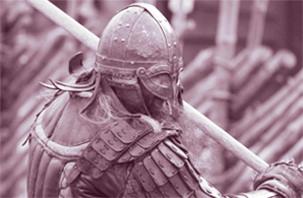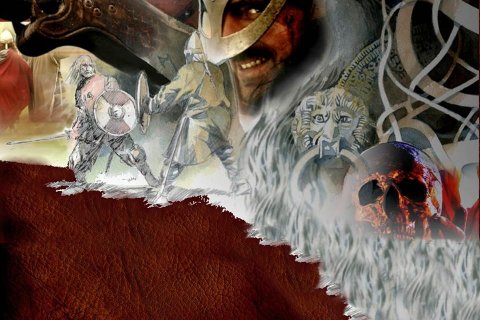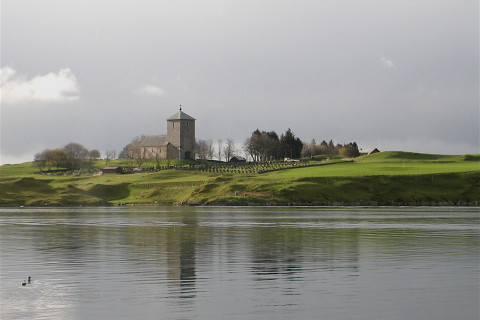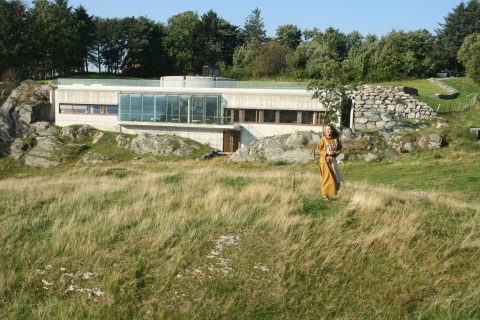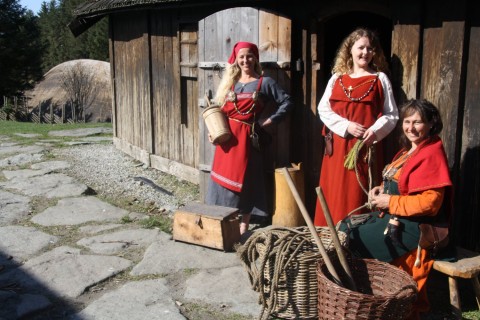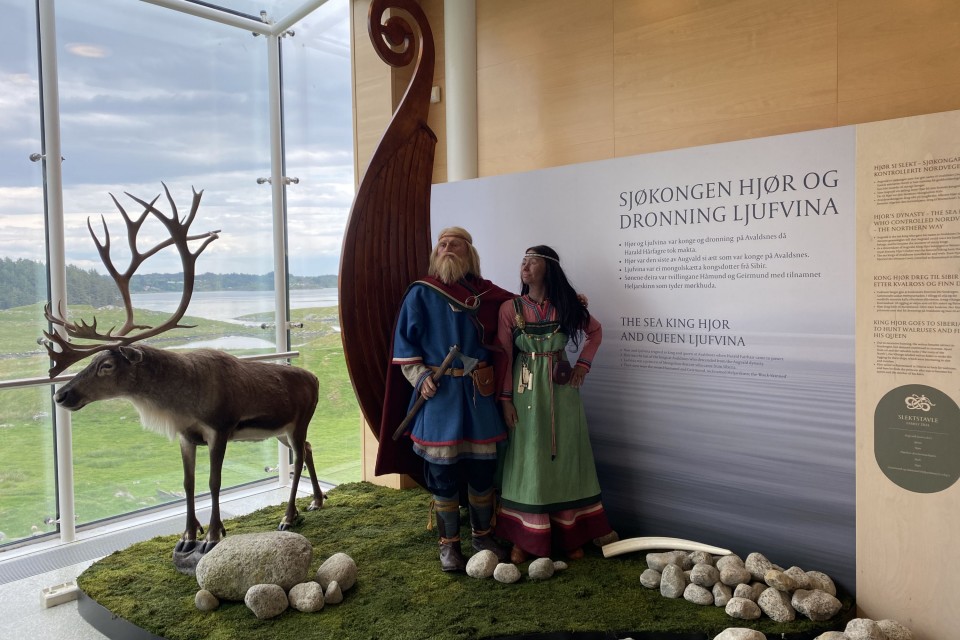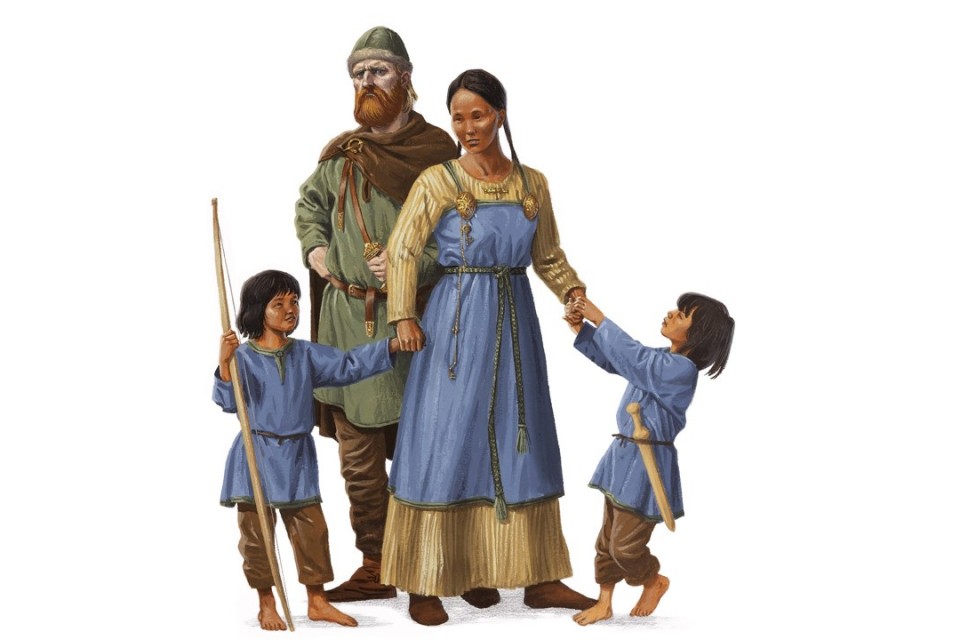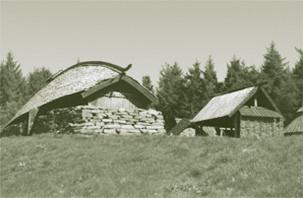Hjor

Hjor’s journey to Bjarmeland. (Ill. Bergsveinn Birgisson ”Den Svarte Vikingen”)
Text Marit Synnøve Vea
Hjor is called Hjør in Norvegian, and Hjorr in Old Norse, a word that means sword. Hjor and Ljufvina reigned as king and queen at Avaldsnes when Harald Fairhair came to power. Hjor was the last of the kings at Avaldsnes who descended from the Augvald dynasty.
His wife Ljufvina was a princess of Mongolian descent and despite her dark skin and unusual looks, she reigned as queen over the Norsemen at Karmsundet.
Hjor and Ljufvina had two sons: the twins Hamund (Håmund) and Geirmund. They, too, had dark skin and were therefore nicknamed Heljarskinn; the “Black-Skinned”.
Geirmund the Black-Skinned – the black Viking – never became king at Avaldsnes. But in old sources he is called a sea-king who became an ally of the Dublin kings before crossing the sea to Iceland and earning himself a reputation as “the greatest of all settlers in Iceland”.

In 2012, we found the remains of a stronghold at Avaldsnes. It was built sometime between 600 and 800 AD. Such installations are evidence of turbulent times. Was it Augvald or his descendants who built this stronghold? (Photo. Ø. Iversen)
Hjor’s dynasty – the kings who controlled Nordvegen – the “Northern Way”
King Hjor belonged to Western Norway’s leading royal dynasty, and as a descendant of Augvald, he could trace his family roots back to divine beings. Hjor’s father was the Viking hero King Halv, who became famous during his lifetime.
The power of the Avaldsnes kings stemmed from their control of trade and ships along the “Nordvegen” fairway. According to the saga, the kings of Avaldsnes travelled far and wide themselves and we are told that even Hjor’s grandfather, Hjorleif the Woman-Lover, travelled to Bjarmeland in Siberia.
King Hjor goes to Bjarmeland to hunt for walruses and finds his queen
Hjor knew about Bjarmeland and the natural resources that were to be found in this country far to the north, where the walrus represented the greatest source of riches. Due to excessive hunting, the walrus became extinct in Nordvegen. But demand continued to increase. Apart from oil and the valuable tusks (“the ivory of the North”), the Vikings needed walrus hides to make the rigging for their ships, which were increasing in size and number.
Hjor sailed to Bjarmeland to look for walruses, and here he finds the Bjarmeland princess who was to become his queen and the mother of his heirs.
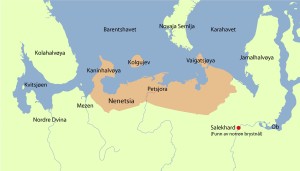
Map of Samoyed territory.
(Ill. B. Birgisson ”Den svarte vikingen”)
Ljufvina’s background
Ljufvina came from the Sikhirtya tribe, a Mongolian people belonging to the indigenous populations of Siberia. They lived by the coast, along the eastern border of an area that the Norseman called “Bjarmeland”.
The Sikhirtya made a living from catching marine mammals and were highly skilled walrus hunters. Their dark skin and language distinguished them from other Samoyed peoples. Russian excavations have revealed that an advanced maritime culture existed in Northern Siberia.
16th century writings tell us that there were two types of Samoyed. The Sikhirtya people are described as “the other, black Samoyeds”. The word Sikhirtya comes from the language of the Nenets and means “people with a black face/appearance”. The Sikhirtya people have now been assimilated into the Nenet culture.

Samoyed women. From Nansen’s expedition to Siberia in the early 1900s.
(Photo: From Nansen’s book: Through Siberia).
Hjor and Ljufvina’s marriage
The marriage between Hjor and Ljufvina was arranged as an alliance in order to keep control of the walrus trade.
In the Viking era, marriage was a family matter whose purpose was to create advantageous alliances and connections of a practical, economic or political nature. Love was not something that was taken into account when marriage alliances were entered into. Nevertheless, people did find love – both within and outside marriage.
Ljufvina, a dark-skinned queen at Avaldsnes
Ljufvina left her family, home and people behind and arrived in an alien culture. According to the saga, her husband Hjor was often away on his travels.
What was Ljufvina’s life like as a foreign, dark-skinned woman at Avaldsnes? Did she bring some of her own people with her? Her name, Ljufvina, means “the friendly lady”.
Ljufvina exchanged her twin sons for the son of a slave
Ljufvina gave birth to twins in about 850, while Hjor was away at a meeting with kings. Geirmund and Hamund resembled their mother. They are described as “ugly, dark and hulking”.
Ljufvina exchanged her twin sons for the blond son of a slave, Leif, and told Hjor that Leif was his son. Why did she do such a thing? Was she afraid that Hjor would be disappointed and would not accept the twins as his heirs because of their Mongolian looks? Did she want to safeguard her own position?
When the boys reached the age of three, the bard Brage the Old revealed the truth about the twins. He recognised “royal” characteristics in the boys: they were “clever with words”, had leadership qualities and demanded that justice be done.

Nenets in front of the tent. Did Geirmund and Hamund look like the children we see here? (Photo: From Nansen’s book: Through Siberia)
Two are inside here,
I trust well both,
Hamund and Geirmund,
Hjor’s own offspring.
But Leif the third,
The son of Lodhott,
Rear him not Queen,
Few will prove worse (Brage the Old in Half’s saga, translation Peter Tunstall)
Ljufvina then told about the exchange. Hjor was allowed to see his real sons and called them heljarskinn “Black-Skinned”. So, the boys won their rightful status as the king’s sons after all.
In the Tale of Geirmund Heljarskinn in Sturlungusaga we can read this about this incident:
The queen gets up now and goes off with the boys and swaps them back with the bondswoman. The truth is now apparent to the queen: that they’ve become more promising lads than they seem, as they had every right to be. And in the evening, when the king came home and had sat down in his throne, she goes before him, taking the boys with her and tells him the whole story, and how she’d made a deal with the bondswoman, and begs him not to be angry.
The king looked at the boys and said, “I’m pretty sure these boys are of my kin, but I’ve never before seen such deathlike skin as these boys have on them.” And that’s why they were called (*1)Deathskin.
And as soon as they were in their prime, they put to sea and set out raiding and soon won both wealth and fame, and for a long time they captained a great fleet, according to what it says in some reports, and there’s some mention in the latter part of the Saga of Rook the Black of how those brothers were reckoned to be the greatest warriors of all the sea-kings at that time. (Translation by Peter Tunstall)
*1: Hel, meaning dark, is also the name of the being Hel who rules parts of the Norse underworld. Therefor Geirmund’s nick-name Heljarskinn is often translated as Deathskin in English)
What did Hjor and Ljufvina feel for each other?
Perhaps they did eventually come to love each other? There are signs that they did: we learn that Hjor did not take any other wives than Ljufvina, unlike the practice of many other kings in the time of the Vikings. Neither are there any reports of him having children with any other women than Ljufvina.
Ljufvina’s sons are dark-skinned and resemble their mother. There is nothing to suggest that they inherited anything of their father’s appearance. In spite of this, Hjor trusted Ljufvina. He accepted the dark-skinned twins as his own sons and heirs.
We do not know what happened to Hjor and Ljufvina when Harald Fairhair settled at Avaldsnes. But we know more about what happened to their two sons, particularly Geirmund the Black-Skinned.

Nenets in Northern Sibera. Perhaps Geirmund looked like the man to the left? (Photo from Nansen’s bok: Through Siberia)
Geirmund the Black-Skinned – the black Viking
Written sources call Geirmund a seafaring king. He was away when Harald Fairhair ousted Hjor and Ljufvina from power. Perhaps he was on an expedition to Iceland when the Battle of Hafrsfjord took place? Or perhaps he was on a trade mission to Bjarmeland?
When Geirmund returned home, he learnt that Harald Fairhair had taken control of Nordvegen. He could not therefore go to the family farm at Avaldsnes and claim his allodial rights and his royal throne – at least, not yet. Instead, he sailed to Ireland and sought his fortune further west
Geirmund the Black-Skinned in Ireland
Geirmund is known as the most renowned Viking of the West. Archaeological finds reveal that the county of Rogaland was the area of Scandinavia with the closest contacts with Dublin during the 9th century.
King Hjor had already forged contacts with the power elite in Ireland and Geirmund therefore had many friends and allies there. Amongst them were his twin brother Hamund and Ulf the Squint-Eyed.
Harald Fairhair had taken control of the trade in the North and in Bjarmeland. The Dublin kings needed walruses and seals for their large fleet of ships. The Dublin kings therefore had to find these resources elsewhere or submit to Harald.
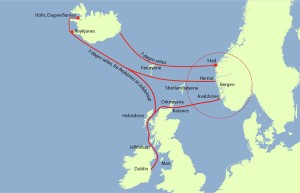
Geirmund’s journeys to Ireland and Iceland (Ill. Bergsveinn Birgisson ”Den Svarte Vikingen)
Geirmund knew that walruses could also be found on a newly discovered island in the North Atlantic: Iceland. He joined forces with the Dublin kings and provided them with ropes, oil and tusks from Iceland. In return, he was given slaves. For Geirmund needed workers, not gold, on this newfound island of resources.
Geirmund the Black-Skinned in Iceland
Geirmund is called the greatest of all settlers in Iceland. He left Ireland with a large number of people, of whom several came from Rogaland and became major players in the so-called “Realm of Geirmund”. Geirmund also took many slaves from Ireland with him to Iceland.
Geirmund’s realm was located at Briedafjord in the West and Northwest of Iceland. It is said that he rode between his farms accompanied by 80 men. In comparison, Harald Fairhair only had an entourage of 60 men in times of peace.
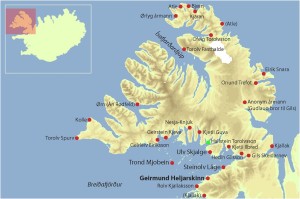
“Realm of Geirmund” in Iceland.(Ill. Bergsveinn Birgisson ”Den Svarte Vikingen”)
Geirmund’s power depended on walrus hunting. Geirmund had learned how to process and use walrus products from his relatives in Bjarmeland. Perhaps some of them accompanied him on his travels to Ireland and Iceland.
Family tree of King Augvald
|
Fornjot (Ymir) |
| Ægir – |
Kåre (Vind)- Loge |
|
Frost |
|
Snø |
|
Thorre |
| Gor – |
Nor – Goe |
|
Gard Agde |
|
Rugalf |
|
Rognvald |
|
Augvald(ca 600 e.Kr.?) |
|
Jøsur |
|
Hjør Jøsurson |
|
Hjørleiv den kvinnekjære |
|
Halv |
|
Hjør Halvson |
|
(Flein Hjørson) |
| |
(Hjør Fleinson) |
|
Geirmund og Håmund Heljarskinn (Settlers in Iceland) |
(The text is based on the book “The Black Viking” and old scriptures obtained by scientist and author Bergsveinn Birgisson)
(Bergsveinn Birgisson uses the genalogy found in Landnamabok (Book of Settlement) where Hjor, married to Ljufvina, is the son of King Half. Others, like P.A. Munch,suggests that Hjor, married to Ljufvina, is the grandson of king Halv. He believes that two persons with the name Hjor have become one, and that two generations are lost in the genealogy. P.A. Munch explains this by pointing out that in the Saga of King Halv and his heroes Hjor Halvsson is married to Hagny, daughter of Hake Håmundsson. According to P.A. Munch the genealogical line from King Half to Geirmund Heljarskinn will be as follows: Hafv – Hjor Halfsson married to Hagny – Flein Hjorsson – Half Fleinsson married to Ljufvina – Geirmund Heljarskinn.)
Back

